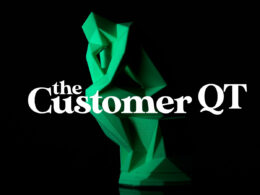2020 revolutionized brand-customer relationships. New habits emerged and accelerated, expectations evolved, and how shoppers consume and connect will never be the same. Given the permanence of changes in customer behavior, identifying and adjusting to the new consumer psychology is a priority.
To better understand these new customer attitudes toward marketing, we went straight to the source. In our 2021 Consumer Psychology Survey, we polled 1,000 shoppers in the U.S. and U.K. Our inquiries explored the true psychology of brand engagement and examined how specific marketing messages really make people feel.
Our survey made one thing loud and clear: Consumers now expect more from brands. Generalized, cookie-cutter customer experiences are ignored and abhorred. But how can brands build campaigns that connect and convert for the long term?
Read our topline trends and findings to learn how to create a customer experience that is individualized and human.
Consumer Psychology Survey Key Takeaways
1. Positive or negative, you can be sure consumers will share their brand experience with others
Old fashioned word-of-mouth reigns supreme, and digital communication channels give their voices a megaphone.
The top actions consumers take to express their satisfaction and dissatisfaction with a brand are either recommending the brand to friends and family (67%) or warning their friends and family (51%) after having a negative brand experience.
The second most common action consumers took is also similar for both a positive and negative brand experience, with respondents saying they’d either make a future purchase or never make a purchase again as a result.
We live in a social media-dominant society, and 29% of respondents said they take to their social channels to voice their brand satisfaction, with 21% doing the same to share dissatisfaction. However, these findings indicate that trust in a brand is still heavily dictated by the one-to-one and one-to-few interactions consumers have within their close circles.
Actions consumers take following positive and negative brand experiences
| Positive experience | Negative experience |
| 1. I recommend the brand to my friends and family (67%) | 1. I warn my friends and family about the brand (51%) |
| 2. I will make another purchase from the brand in the future (57%) | 2. I will not make a purchase from the brand ever again (47%) |
| 3. I write a positive review online (50%) | 3. I reach out to customer service directly (47%) |
| 4. I write about my experience on social media (29%) | 4. I write a negative review online (28%) |
| 5. I reach out to customer service directly (25%) | 5. I write about my experience on social media (21%) |
| 6. I do nothing (4%) | 6. I do nothing (5%) |
2. A sales-driven tone prompts the most consumer action
Want people to make a purchase, subscribe to an email list or follow you on social media? Show them the deals.
A promotional/sales-driven tone resonated the most with consumers across all three marketing touchpoints we studied (purchases, content subscriptions and social media). Respondents said they’re next most likely to gravitate toward an empathetic tone.
These insights are a call to marketers to not overthink their customer engagement efforts. While that doesn’t mean other factors don’t play into brand relationships (more on that later), marketers should still prioritize the promotion of their products and services first.
Another surprising finding was that 16% of respondents said they don’t follow brands on social media. While social media marketing has taken precedence for many brands, the data here confirms that email still has the edge in consumer communications.
Marketing tones that resonate with customers across various brand touchpoints
| Rank | Purchases | Email/newsletter subscriptions | Social media follows |
| 1 | Promotional/sales-driven (53%) | Promotional/sales-driven (49%) | Promotional/sales-driven (36%) |
| 2 | Empathetic/conversational (16%) | Empathetic/conversational (16%) | I don’t ever follow brands on social media (16%) |
| 3 | Authentic/original (10%) | I don’t ever subscribe to brand email lists or newsletters (10%) | Authentic/original (13%) |
| 4 | Urgent/FOMO (8%) | Authentic/original (9%) | Urgent/FOMO (12%) |
| 5 | Inclusive/socially-driven (6%) | Urgent/FOMO (6%) | Empathetic/conversational (12%) |
| 6 | Aspirational (4%) | Inclusive/socially-driven (4%) | Inclusive/socially-driven (5%) |
| 7 | Localized (3%) | Localized (4%) | Localized (4%) |
| 8 | *No answer choice for “I don’t ever buy from brands” | Aspirational (2%) | Aspirational (3%) |
3. It’s time for brands to verbalize their values
Eighty-seven percent of consumers said they’re more receptive to a brand’s messages if they know the company’s beliefs and values. As to why this resonates so well in consumer psychology, respondents said knowing a brand’s beliefs and values makes them feel more trust toward the brand (62%), better know the brand’s authentic identity (44%) and better believe the brand’s purpose (34%).
We also saw this thinking play out in regards to marketing messages with political and social issues. Nearly three-quarters of respondents (71%) said they felt positive toward a brand after receiving a social or political marketing message.
For Iterable’s recent brand trust survey of marketers, 83% said their company should remain politically neutral. However, consumers’ willingness to receive social and political messages shows that marketers’ priorities are misaligned with what their target audiences are looking for.
4. Brands should prioritize diversity, equity and inclusion (DEI) in marketing messages
The marketing messages respondents considered most essential were diverse imagery, inclusive language and setting varied price points/payment plans to accommodate different socioeconomic groups.
Consumers also shared similar priorities when asked about their representation in advertisements: 75% agreed that they’re more likely to purchase from a brand when people who look like them are represented in their ads.
These answers indicate that increased conversations around DEI have made a substantial impact on consumer priorities for brand marketing. And brands should consider how they can be more inclusive in their messaging.
In your opinion, which of the following components of a marketing message are most essential?
- Diverse imagery (51%)
- Inclusive language (44%)
- Setting varied price points/payment plans to accommodate different socioeconomic groups (40%)
- Showing women in positions of equal power (30%)
- Providing accessible marketing messages (22%)
- Incorporation of social/political themes in messaging (20%)
5. In the pandemic era of shopping, safety still comes first for consumers
When asked how the pandemic has affected how they receive brand marketing messages, most consumers (38%) said they now prioritize the brand’s customer safety plan. Thirty-one percent of respondents also indicated a preference for localized content and 30% said they need to know a brand’s alternative purchase options, like buy online, pick-up in store (BOPIS) and curbside pickup.
Consumers’ desire for localized content is peculiar since a localized tone didn’t resonate with various marketing touchpoints. However, this difference could be a matter of how brands leverage geolocation. It appears that consumers prefer localized messaging for promotional messages like brand awareness, but not transactional messages such as product or service deals.
6. With great data comes great responsibility
The large majority of consumers (58%) said they feel positive about receiving a hyper-personalized online ad, and 23% said they feel neither positive nor negative about the matter. In comparison, 19% said they feel negative about receiving hyper-personalized ads, with only 8% saying they feel very negative.
Data privacy is paramount when it comes to brand trust. But data doesn’t have to be a divider—it’s evident that consumers want a personalized experience and aren’t against their information being used for targeted marketing. Brands must take this opportunity to connect with consumers but must act responsibly with the personal data they share.
Creating Authentic Experiences Through Humanity
For today’s consumers, brand-customer relationships must go beyond the transaction.
Our consumer psychology survey found that sales-driven tones drive people to shop and subscribe. But remember: marketing touchpoints are important but they are pieces of a larger puzzle: the dynamic relationship between brands and customers.
It’s clear that consumers want brands to be more human. People want to know brands’ beliefs and values. Customers want to know how brands feel about social and political matters—and how they’re championing DEI in their marketing initiatives. And they want a personalized customer experience that offers a deeper connection with the brands they engage.
We hope these insights can help you make informed decisions that drive a human connection in your customer relationships. To learn how to act on our findings, and create memorable customer experiences, check out content from Iterable’s recent annual conference, Activate Live.
And if you’re ready to modernize your marketing strategy with more personal customer relationships, book a demo with Iterable today.
This article originally appeared in Iterable. Iterable is a cross-channel platform that powers unified customer experiences and empowers marketers to create, optimize and measure relevant interactions and experiences customers love. Leading brands, like Zillow, DoorDash, Calm, Madison Reed, and Box, choose Iterable to power world-class customer experiences throughout the entire lifecycle.
Photo by Autumn Goodman on Unsplash.














2 comments